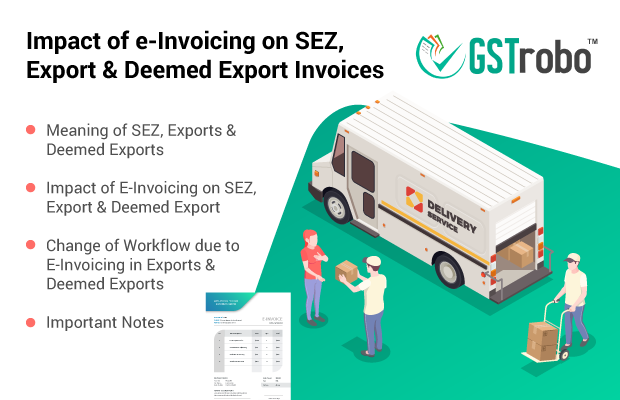Impact of E-invoicing on SEZ Invoices
E-Invoicing is considered as one of the major tax reform under GST. The E-invoicing system is proving to be a great tool that is not only improving ease of doing business but also helping in easy GST compliance. However, it is important to discuss what is the impact of e-invoicing on SEZs’, Exports, and Deemed Exports invoices. So, in this blog, we will discuss the same.

Meaning of SEZ, Exports, and Deemed Exports
SEZ under GST
SEZ is an acronym for Special Economic Zone. It is a separate area that is present inside the territorial boundaries of India notified by the Central Government as a tax-free territory and is deemed to be foreign territory for trade operations, duties, and levies. There are two distinct entities under SEZ namely;
- SEZ Developer: A private sector entity, granted permission by the Central Government to set up a special economic zone area to perform different business activities.
- SEZ Unit: Any business unit that is present in the special economic zone.
Export under GST
Export means the sale of goods or/and services outside India. Under GST Law, GST is not applicable to the export of goods or services as they are considered as zero-rated supply. So, in the case of export, an exporter has two options:
- Exporting goods or/and services under LUT/bond without payment of tax.
- Exporting goods or/and services by paying GST and then claim a refund.
Deemed Exports under GST
The Government may inform certain supplies of goods or/and services as Deemed Exports. Under deemed exports, the goods or/and services supplied/rendered is not sent out the Indian Territory, and the payment for such supplies is received either in INR or in convertible foreign exchange in the event that they are manufactured in India (Section 147 of CGST Act 2017).
Impact of E-Invoicing on SEZ, Export, and Deemed Export
As we already know E-invoicing is applicable to export and deemed export supplies. This step was taken by the government to automate the refund process to exporters under the accompanying cases:
- Refund on export services where the tax payment is made.
- Refund of the unutilized ITC on exports where the tax payment is not made.
- Refund of tax payment on supplies made to SEZ Unit/SEZ Developer.
- Refund of unutilized Input Tax Credit with regards to sales made to SEZ Unit/SEZ Developer where the tax payment is not done.
- Refund to the supplier/recipient of taxes paid because of deemed export supplies for instance supplies made to Export-Oriented Units (EOU).
Change of Workflow due to E-Invoicing in Exports and Deemed Exports
As per the new e-invoicing system, all B2B and export invoices get verified electronically by the Invoice Registration Portal (IRP) and Invoice Reference Number (IRN) is issued against each invoice along with a QR Code.
Exporters can continue filing data for benefiting incentives. The details include:
- Duty drawback serial number.
- Advance/EPCG approval, and
- MEIS declaration details in the invoice field.
Along these lines, registration on the IRP or e-invoicing won’t have any major impact on the export and deemed export invoices.
Moreover, in the e-invoice schema as per Notification No. 60/2020, there are some extra fields for exports in which the information will get auto-populated from the bill of entry in ICEGATE, for example, currency code, place of supply, country code of export, port code, shipping bill number, date, export duty, and so forth.
Important Notes
- At the time of registration on the IRP as an exporter, one needs to select the type of exporters, for example, regular export, deemed export, supplies from SEZ unit or SEZ developer.
- Exporters can use the existing invoice layout for e-invoicing and capture the QR code.
- As per Notification No. 61/2020, SEZ units are exempted from generating e-invoice. No exemption is available for SEZ developers.

One Reply to “Impact of E-invoicing on SEZ Invoices”
Is E-Invoice applicable for Software exports ?
If so, how to generate E-Invoice as it is not a B2B transaction?